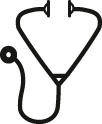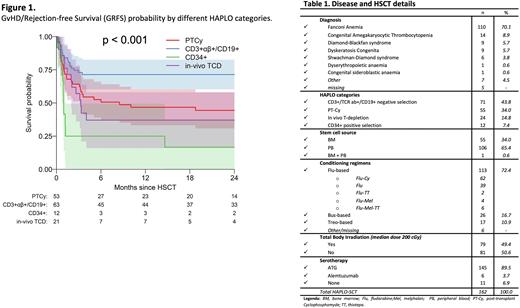Abstract

INTRODUCTION: HLA-haploidentical stem cell transplantation (HAPLO) has been widely used in the last years in children with an indication to receive an allogeneic hematopoietic stem cell transplantation (allo-HSCT) and lacking a matched donor. The introduction of new, more selective techniques of graft manipulation and in vivo T-cell depletion have improved the outcome of HAPLO in several diseases.
Allo-HSCT represents the only well-established cure for the hematological manifestations of inherited bone marrow failure syndromes (I-BMFs), featuring complex molecular pathophysiology resulting in ineffective hematopoiesis and increased risk of progression to myelodysplastic syndrome and acute leukemia. However, data on HAPLO in these diseases are limited.
This retrospective study aims to report the current outcomes of HAPLO in the EBMT network in patients with I-BMFs, comparing the different approaches introduced over the years.
PATIENTS AND METHODS The study was conducted on behalf of the Severe Aplastic Anemia Working Party of the EBMT. Data were collected from patients who underwent HAPLOs of I-BMFs and registered in the EBMT ProMISe database between 1990-2020 with a diagnosi. Clinical and biological information about the disease and details on transplant procedures and outcomes were collected through a specific case report form distributed to participating EBMT centers.
RESULTS Data was collected from 162 patients (53.1% males) affected by I-BMFs undergoing HAPLO in 56 centers. The median age at HAPLO was 7.4 years (IQR 4.9-10.9). Table 1 summarizes the diagnoses and main HSCT details. Most HAPLOs were performed in 2015 (n=125, 77.2%).
Based on different T-cell depletion (TCD) approaches, 4 categories were identified: 1) TCRCD3+ or ab+/CD19+depletion performed in 71 transplants (43.8%); 2) T-repleted with post-transplant Cyclophosphamide (PTCy) in 55 (34.0%); 3) in vivo T-depletion approach in 24 (14.8%; 20 ATG, 4 anti-CD52); and 4) CD34+ positive selection in 12 (7.4%).
Neutrophil and platelet engraftment occurred on day + 14 (95% CI 13-15), and +18 (95% CI 16-21) respectively. Primary graft rejection was diagnosed in 14 children (10% [5-14%]), while 11 experienced secondary graft failure (8% [3-12%]).
The 100-day cumulative incidence of grade II-IV and III-IV acute GvHD (95% CI) was 29 % (22-36) and 13% (8-19), while the 24-month cumulative incidence of chronic GvHD was 11% (6-16%) and that for the extensive form was 4% (1-7%).
After a median follow-up of 43.4 months (IQR 32.9- 51), the 2-year overall survival (OS) and GvHD/Rejection-free Survival (GRFS) probability are 67% (60-74%) and 53% (45-61%) respectively (Figure 1). The main causes of death were infections (40.4%), GvHD (28.8 %), other HSCT-related events (28.85 %), and relapse of acute leukemia in 1 patient with malignant transformation (1.9 %).
When we analyzed the outcome by the modality of TCD, the TCR CD3+ab+/CD19+ depletion group showed the best OS (79%) and GRFS (71%) that were significantly higher (p 0.013 and p <0.001, respectively) than those observed in the other groups. (Figure 1). The TCR CD3+ab+/CD19+ depletion group also was associated with a lower incidence of acute (15%, vs 46 % PT-Cy, vs 9% CD34+ positive, vs 41% in-vivo TCD; p 0.001) and chronic GvHD (9%, vs 19% PT-Cy, vs 0% CD34+ positive selection vs 0 % in-vivo TCD; p < 0.041).
No differences in outcome were observed based on the underlying diagnosis.
CONCLUSION This is the largest retrospective study on HAPLO in I-BMFs comparing the main TCD approaches and the long median follow-up of almost 4 years contributes to the reliability of the data reported.
The satisfactory outcome supports HAPLO HSCT as a safe and effective alternative for patients lacking a full-matched donor. The most widely adopted approaches are TCR CD3+ab+/CD19+ depletion and PT-Cy. PT-Cy is largely used because of its easy accessibility, but for the time being, the TCR CD3+ab+/CD19+ depletion platform offers the highest OS and GRFS and the lower incidence of both acute and chronic GvHD in I-BMFs.
Disclosures
Dufour:Novartis: Consultancy; Gilhead: Consultancy; Pfizer: Consultancy; Biocryst: Consultancy. Risitano:Amyndas: Consultancy; Novartis: Honoraria, Membership on an entity's Board of Directors or advisory committees, Research Funding, Speakers Bureau; Apellis: Honoraria, Membership on an entity's Board of Directors or advisory committees, Speakers Bureau; Sobi: Honoraria, Membership on an entity's Board of Directors or advisory committees, Speakers Bureau; Roche: Membership on an entity's Board of Directors or advisory committees; Pfizer: Honoraria, Speakers Bureau; Alnylam: Research Funding; Ra Pharma: Research Funding; Achillion: Membership on an entity's Board of Directors or advisory committees; Samsung: Membership on an entity's Board of Directors or advisory committees; Alexion: Honoraria, Membership on an entity's Board of Directors or advisory committees, Research Funding, Speakers Bureau.
Author notes
 This icon denotes a clinically relevant abstract
This icon denotes a clinically relevant abstract
Asterisk with author names denotes non-ASH members.


This feature is available to Subscribers Only
Sign In or Create an Account Close Modal